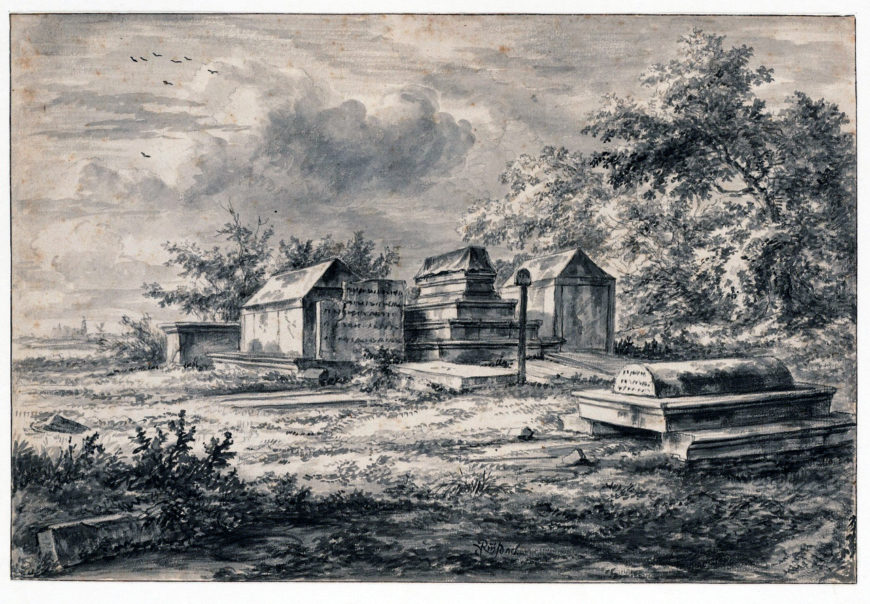Standing in front of Jacob van Ruisdael’s Jewish Cemetery at the Detroit Institute of Arts, a visitor is surrounded by paintings made by Jacob and other members of the famous Ruisdael family of Dutch landscape painters. While all the paintings in the room are landscapes, the Jewish Cemetery stands out as noticeably different than the others—though all the works share similar subject matter, and all were painted by Jacob, his father Issack, and his uncle Salomon.
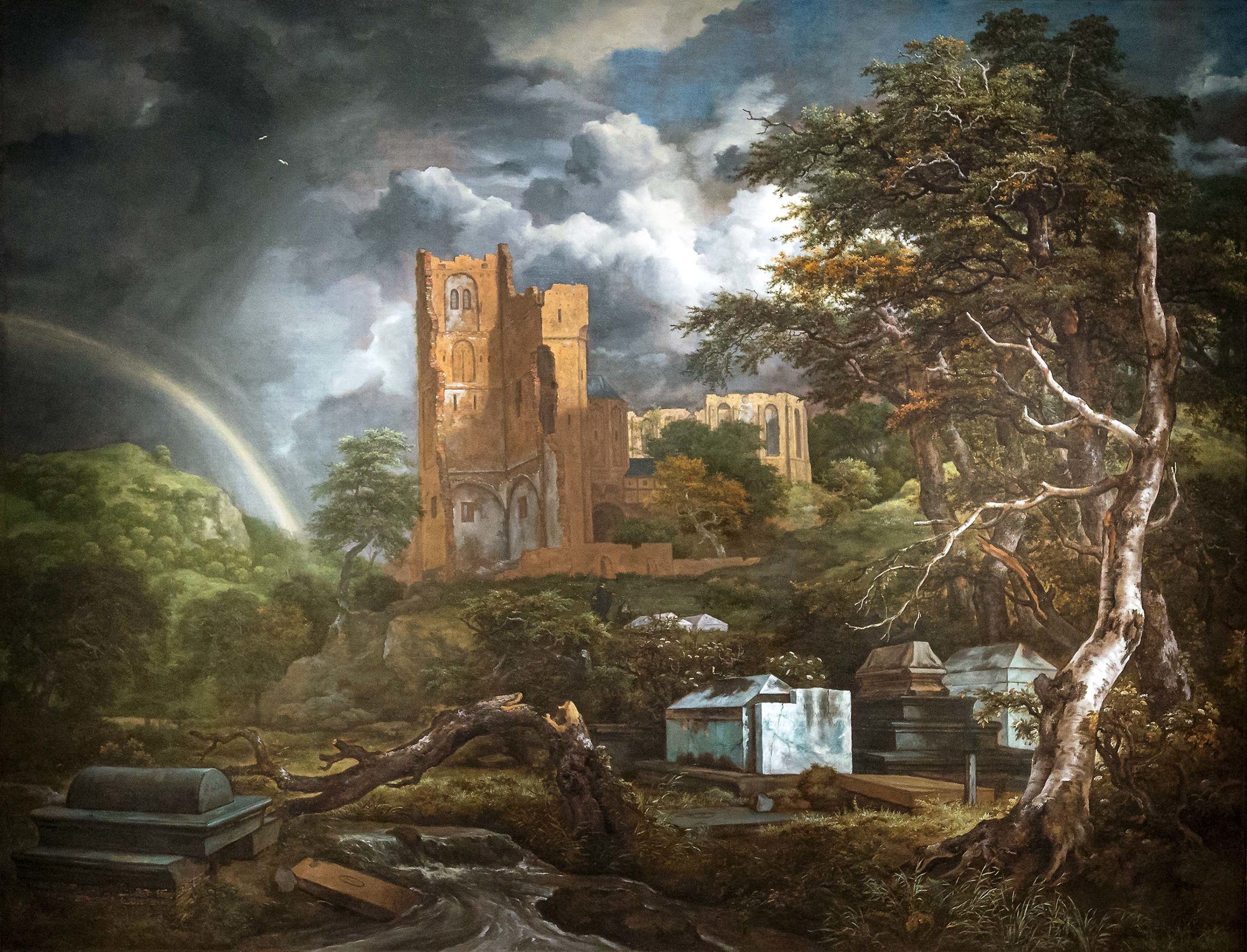
Jacob Isaaksz van Ruisdael, The Jewish Cemetery, 1654 or 1655, oil on canvas, 142.2 × 189.2 cm (Detroit Institute of Arts)
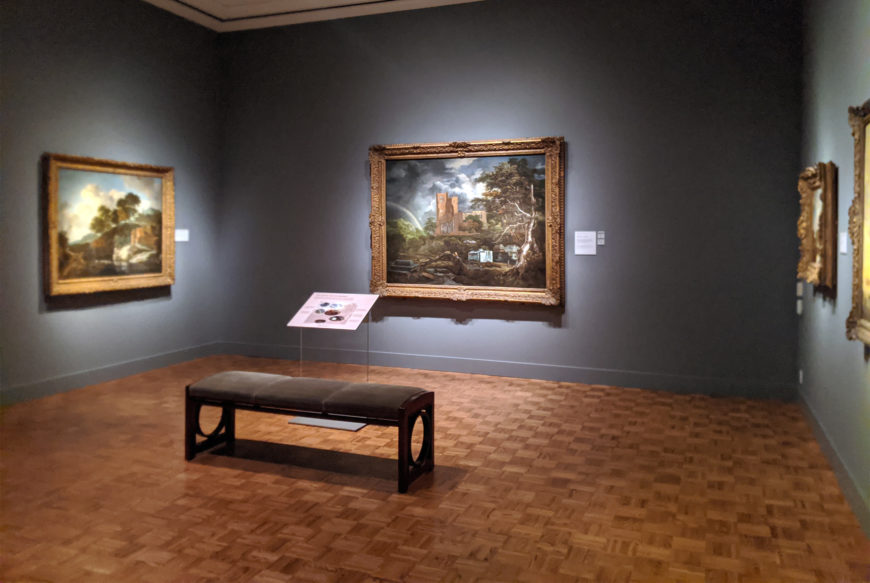
Gallery view with Ruisdaels, Detroit Institute of Arts (photo: Dr. Theresa Kutasz Christensen)
The first thing the viewer might notice is how large the painting is. The Jewish Cemetery is double or triple the size of most of the other landscape paintings in the DIA’s Dutch Golden Age (17th century) galleries. This larger-than-usual scale, along with the play of light and dark and the dynamic lines that move the eye around the canvas, draws comparisons with Baroque compositions popular elsewhere in Europe. Jacob van Ruisdael is considered by many to be the greatest Dutch landscape painter of the 17th century in part because of his ability to enliven his work through these conventions borrowed from other popular genres of painting such as portraiture and still life. He is known not only for the wide variety of subjects he portrayed in his landscapes, seascapes, and cityscapes but also for imbuing these everyday views with emotional interest through composition, coloring, and viewpoint. The emotional impact of The Jewish Cemetery is created by forcing the viewer to confront vast and overwhelming powers such as God, time, and the natural world, eliciting simultaneous feelings of horror and fascination. This sort of fear and astonishment is often called the Sublime, and it is a concept that reaches back to antiquity but was widely popularized in the mid-18th century by Edmund Burke. Because of the painting’s success in creating emotional drama, The Jewish Cemetery is often considered a precursor to later images of the Sublime in landscapes and marine paintings of the 18th and 19th centuries. As we can see in a closer examination of The Jewish Cemetery, his works were closely based on, but not entirely beholden to, the world he saw around him.
Subject and symbols
The true center of The Jewish Cemetery is also the compositional center and focal point of the work. This means that the physical center of the canvas is also the spot where your eye goes first when looking at the painting. The viewer enters the painting at the center where the ruins of a church catch light that filters through the cloudy sky. The eye then wanders down, drawn by the bright white stone of the tomb with a broken slab covered in text. The eye shifts left at the bottom of the painting but is stopped by a broken tree. Following the trickle of the stream back to the right, the eye moves quickly up the right side of the painting in a sweeping curve that follows the line of the dead tree, coming to a rest among the treetops. The lightning-like branches point the gaze back across a tumultuous sky where dark clouds on the left side of the canvas are broken by a hazy rainbow.
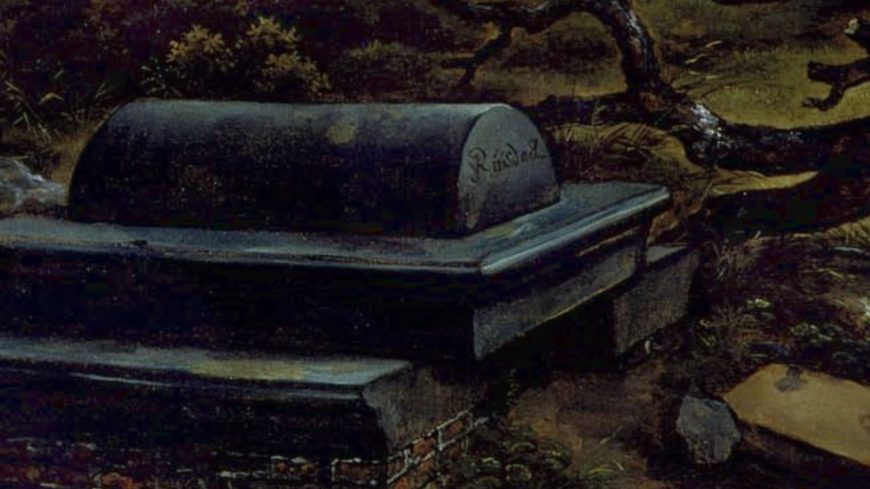
Detail of signature, Jacob Isaaksz van Ruisdael, The Jewish Cemetery, 1654 or 1655, oil on canvas, unframed: 142.2 × 189.2 cm (Detroit Institute of Arts)
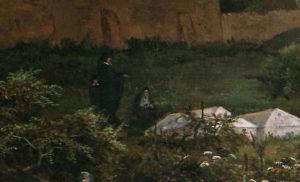
Three mourners, Jacob Isaaksz van Ruisdael, The Jewish Cemetery, 1654 or 1655, oil on canvas, unframed: 142.2 × 189.2 cm (Detroit Institute of Arts)
As the rainbow tapers off at the horizon, it points down toward the bottom of the composition where a large grey tomb sits in the left foreground bearing the artist’s signature “JvRuisdael” on the front. Nearby, a broken slab has fallen into the quick moving stream which flows into the viewer’s space. Above the water, the slant of the broken tree’s trunk leads you back to the center of the painting where the viewer, now satisfied that they have taken in the whole of the canvas, can allow their gaze to rest on details missed in the first look. A group of three mourners stand in the middle distance next to a pair of white tombs with elongated pyramidal lids. A small wood-framed house sits amidst the church ruins, and a group of birds swirl upward in the sky.
Analysis of The Jewish Cemetery typically focuses on deconstructing symbolic elements in the work. The painting is an allegory, meaning that specific objects or elements depicted have hidden meanings for the viewer to contemplate. While allegories are a typical theme in Dutch interiors and still life paintings, van Ruisdael’s use of this sort of visual poetry in a landscape painting was a unique approach. The painting functions as a memento mori (a reminder that everyone will die), while also presenting themes of hope and renewal. The stream is full of water that is constantly moving, changing, and regenerating, symbolizing the vibrance of life while the decaying tree bent over it symbolizes the inevitability of death. The rainbow has been assigned a myriad of meanings but generally is regarded as an image of hope and divine promise. The three mourners at the two white tombs nearest the church simultaneously model and reflect the viewer’s contemplation of death. Like the rainbow in the storm providing hope and divine promise amidst nature’s fury, the mourner’s presence brings the promise of repair and renewal to the neglected sarcophagi. The partial destruction of the Jewish graves is mirrored in the ruinous state of the church. This religious parallel has led to many readings of the painting as a unifying commentary on man’s impermanence, and the inevitability of God, time, and nature, no matter one’s faith.
Location and context
Van Ruisdael’s painting depicts an actual cemetery called Beth Haim on the outskirts of Amsterdam in the village of Ouderkerk on the Amstel River. The site is still in use today (see the Google Street View below) and, since van Ruisdael’s lifetime, it has been the well-known resting place for members of Amsterdam’s large Jewish Portuguese community as well as notable individuals from across Europe. The site was visited by other artists such as Rembrandt and a series of sketches created early in van Ruisdael’s career depicting the cemetery indicate that van Ruisdael spent a fair amount of time observing the location.
While the burial ground is real, visitors to Beth Haim in Ouderkerk familiar with van Ruisdael’s painting may find themselves searching in vain for familiar landmarks. Most of the prominent characteristics depicted in the painting, such as the church ruins, small timber building, stream, and hilly surroundings are inventions of the artist. Some of these features can be found in sketches of other locations by van Ruisdael but are not features of the landscape at Ouderkerk. These elements were added to the scene solely to further the compositional and allegorical goals of the painter.
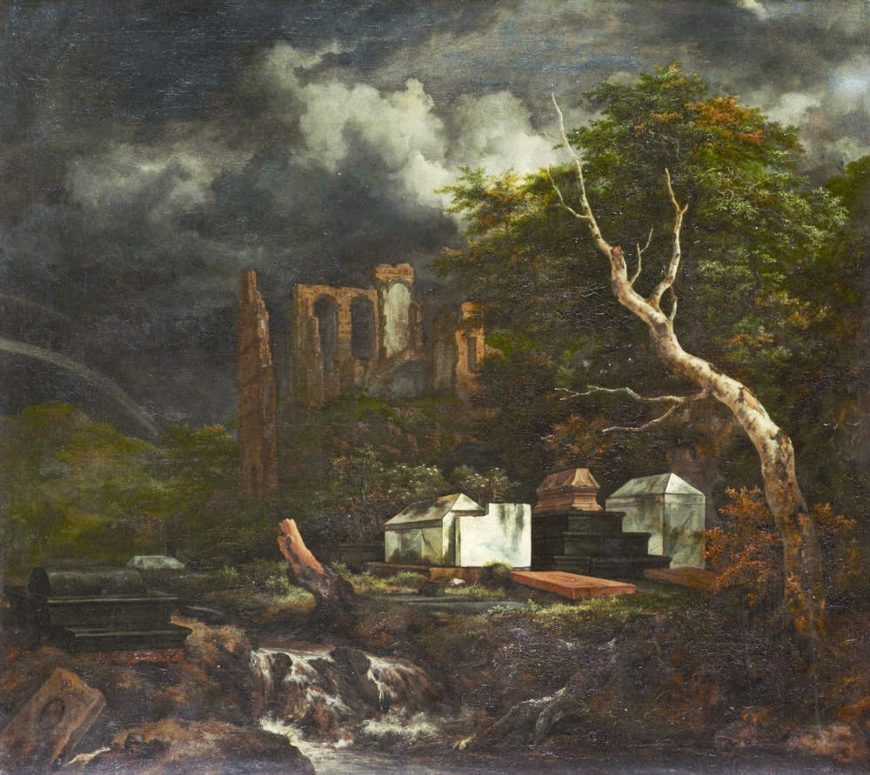
Second version—Jacob Isaaksz van Ruisdael, The Jewish Cemetery, c. 1655, oil on canvas, unframed: 84 x 95 cm (Staatliche Kunstsammlungen Dresden)
Despite artistic liberties taken with the location, van Ruisdael’s cemetery is firmly contextualized by his accurate portrayal of the sarcophagi. In the late 19th century, there was a great deal of research conducted on the history of the Jewish cemetery at Ouderkerk. The slabs were cleaned and restored, and a book was produced which pairs each of the monuments carefully reproduced by van Ruisdael with an extant sarcophagus.
A second version of the painting, now in the Staatliche Kunstsammlungen in Dresden, Germany is generally believed to have been painted after the Detroit version based on elements like its tighter, more studied composition. In it, van Ruisdael alters much of the invented topography but again faithfully renders monuments from the cemetery at Ouderkerk. It is unclear why the artist selected the Jewish Cemetery as the location for these works beyond its suitability for the themes he was interested in depicting and his apparent interest in the distinctive forms of the sarcophagi. Any particular relationship he had with the Jewish Portuguese community is largely unknown as are the identities of the original owners of the two paintings.
Conclusions
In The Jewish Cemetery, Jacob van Ruisdael demonstrates his mastery of landscape techniques learned through careful study and a storied family artistic tradition. His application of allegorical symbols within the scene transforms the cemetery into a landscape variant of a vanitas (still-life paintings featuring objects that allude to the inevitability of death such as clocks, candles, and skulls) image, mixing popular genres to great effect. The painting provides a fascinating jumping off point for deeper investigations into van Ruisdael’s sketches, the origins of the buildings depicted in the painting, the history of the Portuguese Jewish community of Amsterdam, and the cemetery in Ouderkerk on the Amstel. The lasting appeal of van Ruisdael’s work may lie, in part, in his ability to anticipate what was to come in his genre. Over one hundred years after The Jewish Cemetery was painted, the Sublime in art became an increasingly popular theoretical subject. It also became a central component of the dramatic landscapes and marine paintings created by the Romantics, the Barbizon School, British landscape painters, members of the Hudson River School, and many others whose work also encourages emotional engagement through the contemplation of life, death, and nature. Whether one luxuriates in the melancholic landscape or meticulously analyzes its components for symbolic content, van Ruisdael’s cemetery is best understood by allowing it to reveal itself through repeated close looking and contemplation.

Jacob Isaaksz van Ruisdael, The Jewish Cemetery, 1654 or 1655, oil on canvas, 142.2 × 189.2 cm (Detroit Institute of Arts)
Google Street View of Beth Haim today
Additional Resources:
Eye-tracking of The Jewish Cemetery (provided by Dr. Theresa Kutasz Christensen)
See the painting at The Detroit Institute of Arts
George Keys, et. al. Masters of Dutch Painting: The Detroit Institute of Arts. London: GILES, 2004, pp. 198–203.
Ernst Scheyer, “The Iconography of Jacob van Ruisdael’s ‘Cemetery’.” Bulletin of the Detroit Institute of Arts 55, no. 3 (1977): 133–46.
Seymour Slive, Jacob van Ruisdael: A Complete Catalogue of His Paintings, Drawings, and Etchings. New Haven: Yale University Press, 2001, pp. 179–184, cat. 178.
Seymour Slive, Jacob van Ruisdael: Master of Landscape. New Haven and London: Yale University Press, 2005, pp. 84–89.
M. Zell, “Reframing Rembrandt.” Jews and the Christian Image in Seventeenth-Century Amsterdam. Berkeley, 2002, pp. 34–37.

